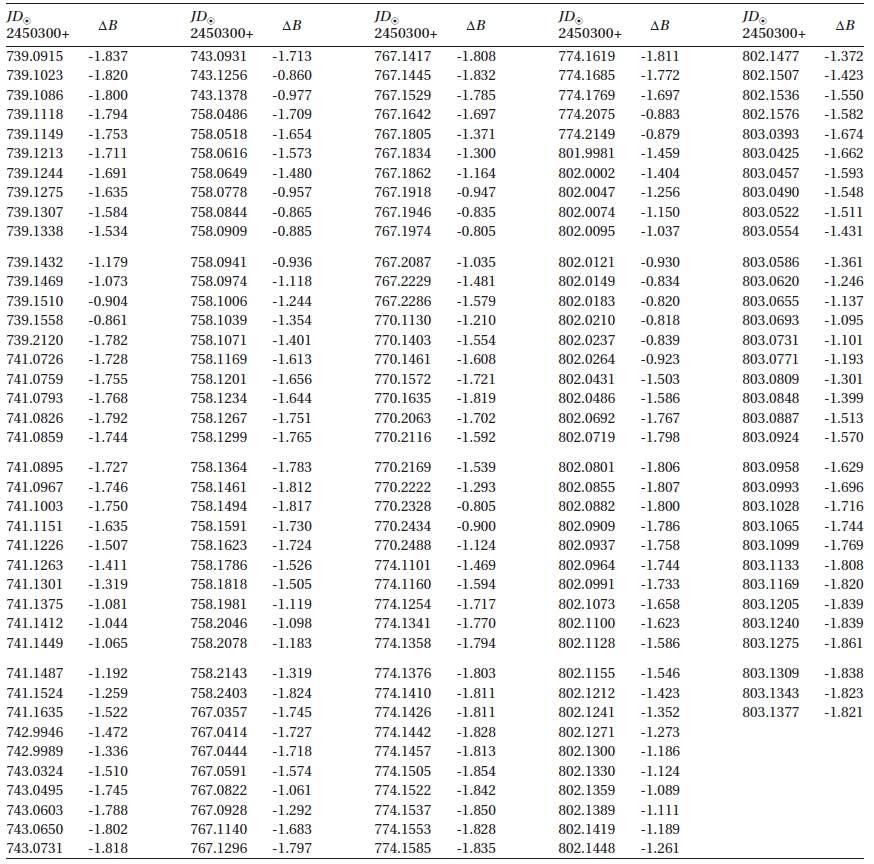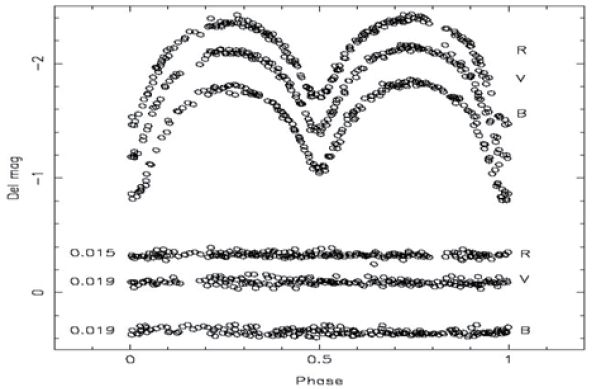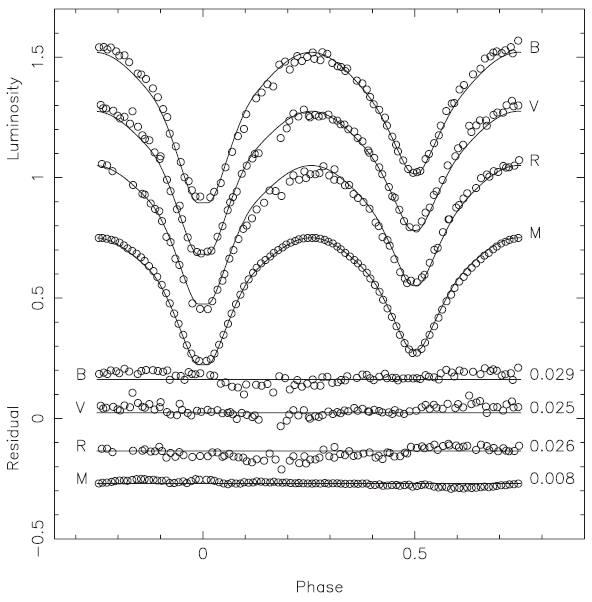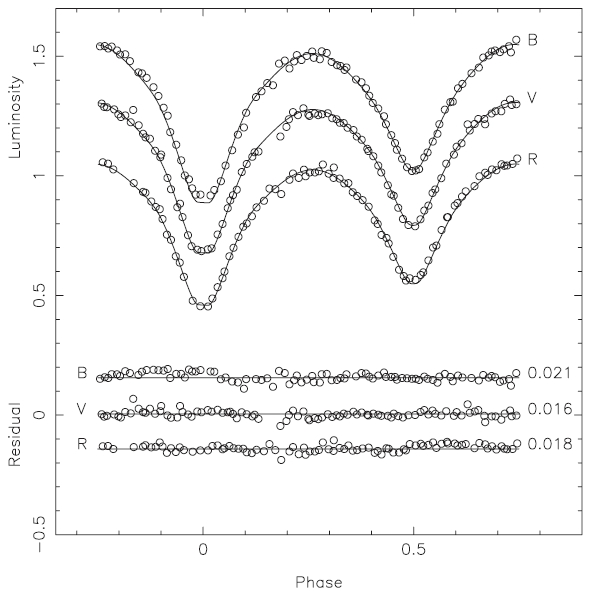



V523 Cassiopeiae (Wr16, CSV5867, GSC 3257-167) is a W-type W UMa eclipsing binary system (the smaller is hotter; see Hendry &;amp; Mochnacki 2000). Since Weber (1958) discovered the light variability of V523 Cas, many investigations in photometry and spectroscopy have been carried out (Zhukov 1972, Haussler 1974, Lavrov &;amp; Zhukov 1975, Bradstreet 1981, Hoffmann 1981, Samec &;amp; Bookmyer 1987, Zhai et al. 1988, Samec et al. 1989, Kim &;amp; Jeong 2002, Samec et al. 2004, Genet et al. 2005, Jeong et al. 2006). In results, some facts about V523 Cas are known: 1) its orbital period of about 336 minutes is one of the shortest among late type contact binaries. 2) Its light curves show a relatively deep eclipse (~0.m8) and probably total at primary eclipse. 3) V523 Cas is noted for variations in its light curve, for rapid changes in photometric light-curve asymmetries, and also for large orbital period changes.
Each component of the V523 Cas system is rapidly rotating compared to most late single stars. It may cause magnetically active phenomena. Genet et al. (2005) tried to determine small changes in rotational periods from one season to the next, with considerable precision. They explained that such small changes in rotational periods can be caused by mass loss, the transfer of mass from one star to the other, or the Applegate (1992) effect. Also they suggested third bodies can induce changes in eclipse epoch due to the light-travel-time effect resulting from the system shifting barycenter.
Samec & Bookmyer (1987) and Samec et al. (1989) reviewed the early history of this system. Mass ratios produced by photometric solutions of V523 Cas are qph = 0.59 by Bradstreet (1981), 0.571 by Samec et al. (1989), 0.53 by Lister et al. (2000), 0.56 by Kim & Jeong (2002), and 0.52 by Samec et al. (2004). Those values disagreed with the spectroscopic mass ratio, qsp = 0.42, derived directly from radial velocity curves by Milone et al. (1985). Niarchos & Duerbeck (1991) had proposed that a circulation effect of sideward convection may affect the radial velocity curves in a systematic way, causing the discrepancy in qph and qsp. However, an analysis of new, high-precision radial velocity curves by Rucinski et al. (2003) has shown that qsp = 0.512. Samec et al. (2004) found that, even with using simultaneous solution method, it is impossible to get a good fit to the light curve and the radial velocity curves. Jeong et al. (2006) obtained
[Table 1.] B observations of V523 Cas in 2008.

B observations of V523 Cas in 2008.
Even the problem of the difference between two kinds of
2. OBSERVATIONS AND LIGHT CURVES
Using the 100 cm reflector equipped with 2K CCD camera system of Chungbuk National University Observatory, we observed V523 Cas on 9 nights in 2008. The stars of GSC 3257-0011 and GSC 3257-0221 are observed for comparison and check, respectively. The observations were reduced using the Image Reduction and Analysis Facility (IRAF) differential photometric method. Differential
With our data, we determined 9 times of minimum light using the Kwee & van Woerden (1956) method, as listed in Table 4, and constructed
[Table 2.] V observations of V523 Cas in 2008.
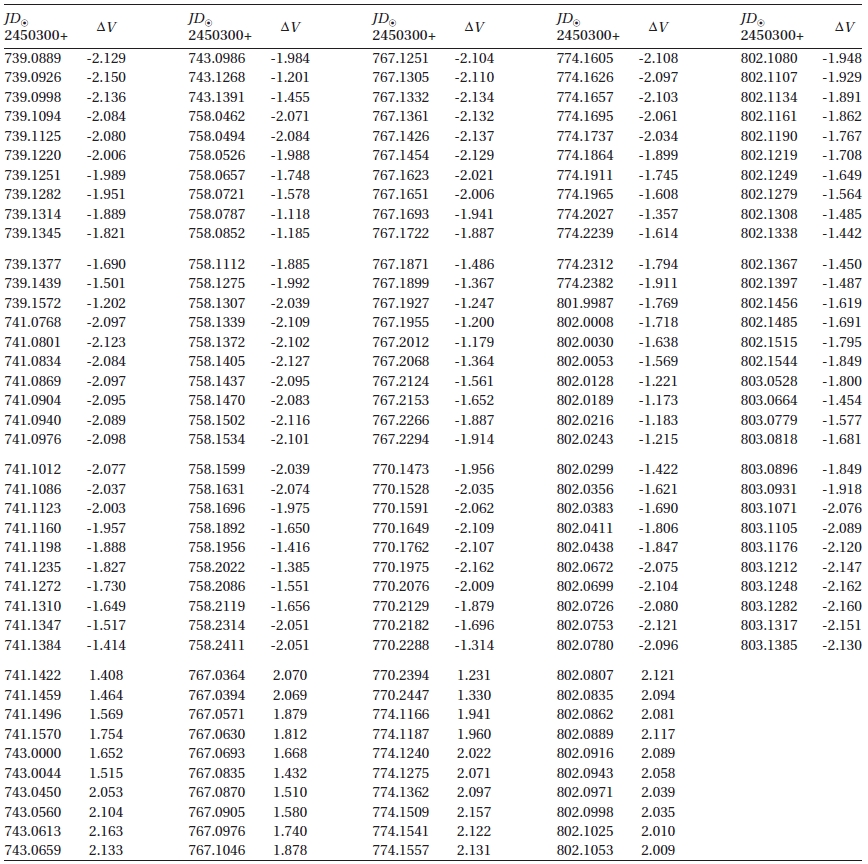
V observations of V523 Cas in 2008.
where the period of 0.d23369722 is adopted from Jeong et al. (2006) and the epoch of
14
It is remarkable that magnitude at the outside-eclipse phase of 0.2-0.3 is quite different to that of 0.7-0.8 in the light curve of Fig. 1. Zhai et al. (1988) explained such an asymmetry is due to the spot activity on the secondary component. The variation in the light curves of V523 Cas takes place in terms of days, weeks, and months. In order to see the figure of variations in residuals (observed minus averaged), Genet et al. (2005) obtained a master light curve (M-curve) by means of phase-binned analysis of their 21248 observations.
We analyzed the light curves of V523 Cas using WD program (Wilson & Devinney 1971, Wilson & van Hamme 2004). For the input data, we made about 50 normal points from our data in each filter, and made the data which are converted from the M-curve of Genet et al. (2005). Mode 3 and model atmosphere were applied. We used
[Table 3.] R observations of V523 Cas in 2008.
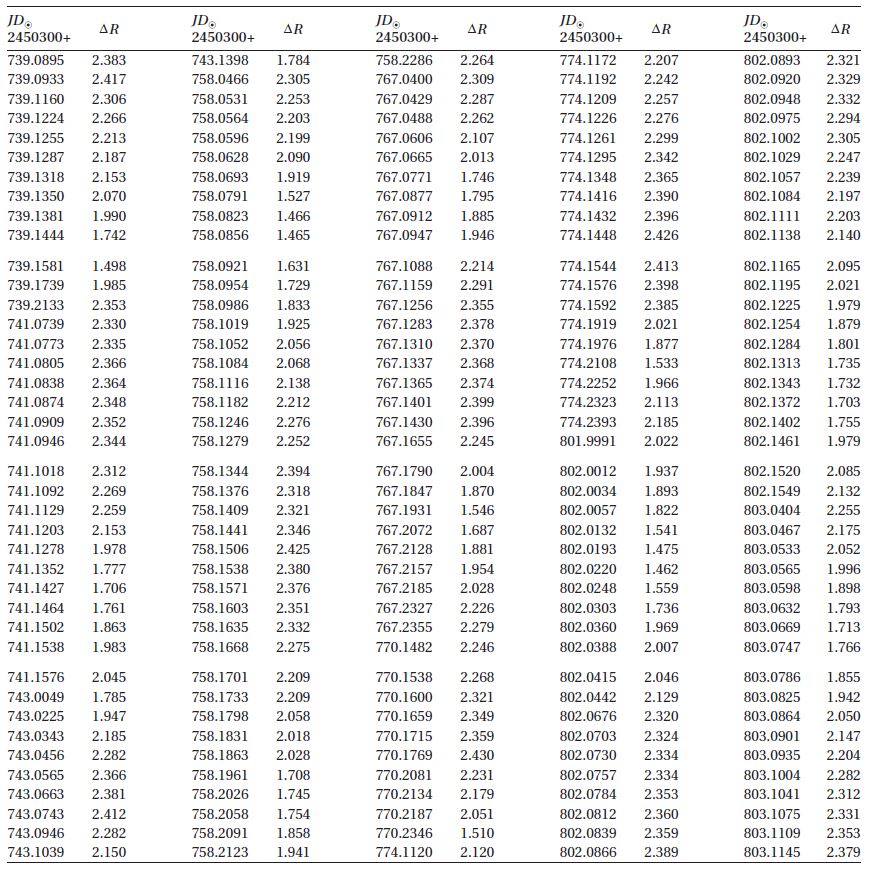
R observations of V523 Cas in 2008.
[Table 4.] Times of minimum light of V523 Cas.
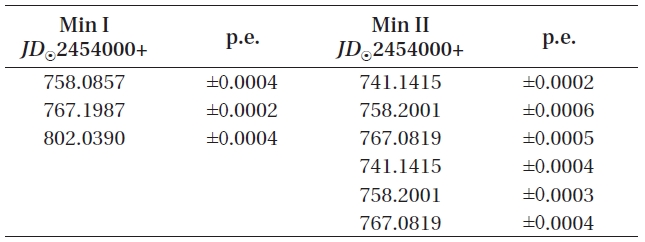
Times of minimum light of V523 Cas.
[Table 5.] Light curve solutions of V523 Cas.
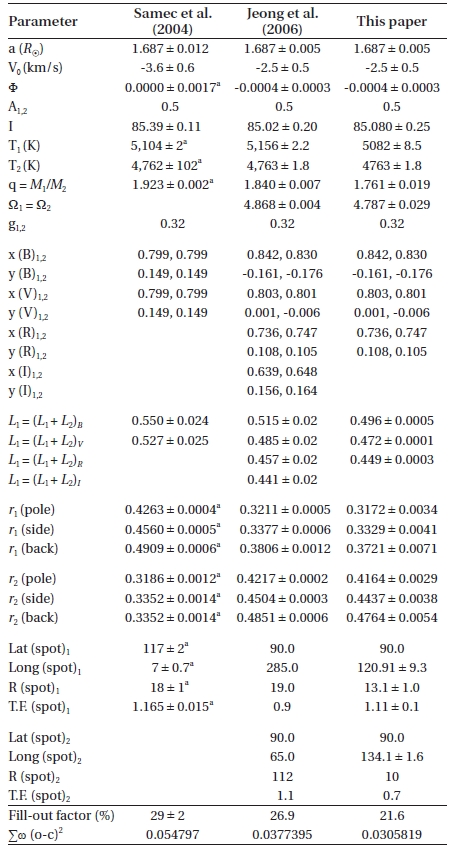
Light curve solutions of V523 Cas.
Two solutions were obtained because the luminosity at the 0.75 phase is much higher than that at 0.25. First, we executed WD differential correction code iteratively, and tried to obtain the best fitting to
[Table 6.] Absolute dimension of the V523 Cas system.
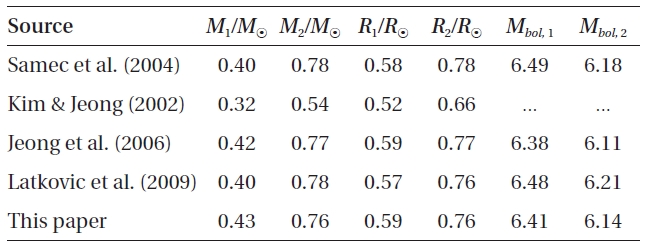
Absolute dimension of the V523 Cas system.
[Table 7.] Over contact factors of V523 Cas system.
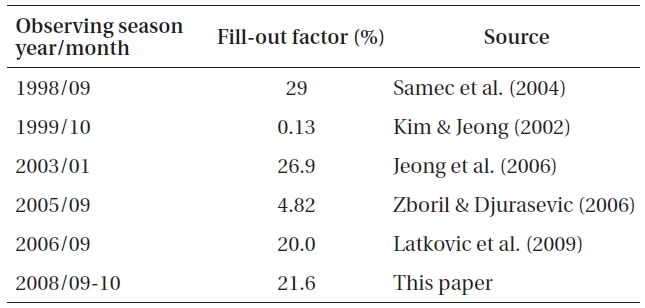
Over contact factors of V523 Cas system.
The synthetic light curves according to our solutions are constructed as shown in Figs. 2 and 3, respectively. On the upper part of those figures, the open circles stand for normal points of our observations and solid lines for the calculated light curves. On the bottom part, together with a plot of the residuals (observed minus modeled) and their probable errors. It is clear that the model light curves with spots (in Fig. 3) better fit the observations than those without spots (in Fig. 2). Probable errors are 0.029 for
Our solution for the V523 Cas system exhibits that the massive, bright and larger component is cooler (see Table 6), and it has a common envelope (fill-out factor 21.6%) but the temperatures of the two components are different (~300 K). According to the published solutions (including ours) for V523 Cas, the position, size and temperature of spots are rapidly changing, and affect light variation. Those observational evidences for V523 Cas are reflecting the existence of very strong magnetic fields due to both their rapid rotation (dynamo effect) and their low temperature, which makes generally deep convective envelopes with long convective turnover times (Rucinski 1993). But most late single stars which are slowly rotating, are not very active, magnetically.
Despite great progress, many problems remain to be studied. Genet et al. (2005) insisted on the necessity of high precision observation. Until now, our observations are like snapshots of W UMa systems, but nowadays with highly developed technology we can provide movies of their behavior over daily, monthly and yearly timescales. This would enable more powerful feedback on the theoretical models and, ultimately, a better understanding of over-contact binary structure and evolution.
This work was supported by the research grant of the Chungbuk National University in 2008. We are very grateful to Dr. R. E. Wilson for allowing us to use his new W-D code.
